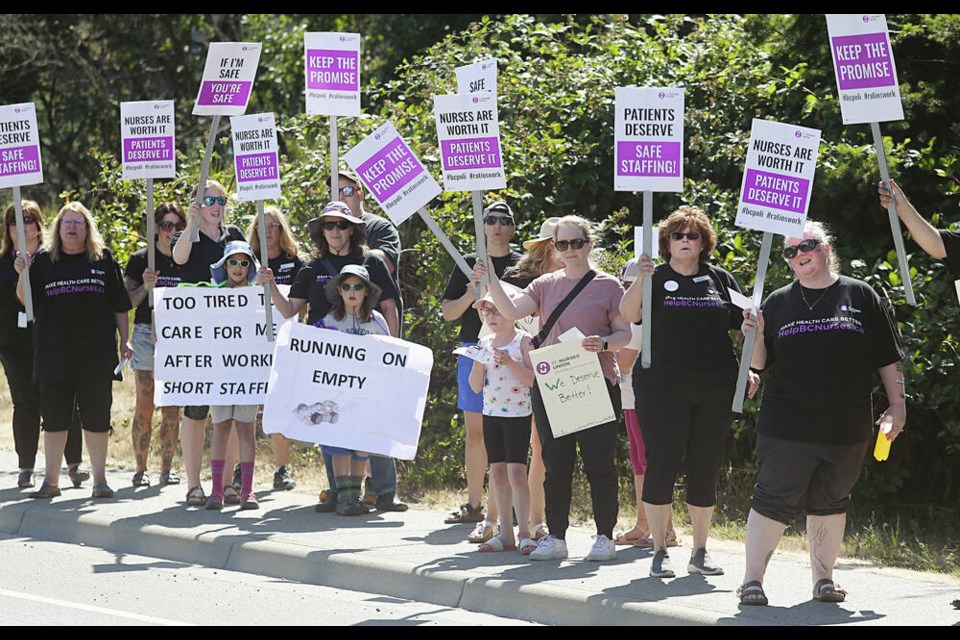Katja Brendt left her full-time nursing job at Victoria General Hospital last year. She’s now a casual nurse at Jubilee Hospital who works two shifts a week.
But even that’s sometimes too much due to the heavy workload resulting from inadequate nurse-to-patient ratios, she said, adding that she needs an additional two days to recover from her two shifts of intense work.
“You try not to take breaks, you work as fast as you can, you try to be as efficient as you can,” said Brendt, one of several dozen nurses who attended a B.C. Nurses’ Union rally in front of Victoria General Hospital on Sunday.
“I have no energy left after 12 hours giving everything to this health-care system.”
Brendt’s two children were also at the rally, wearing hand-made signs. Naira Tzavkov, 10, had a sign that said: “Too tired to care for me after working short staffed.”
“I don’t like how Mommy’s always tired since she can’t even read us stories before she has to go and take a nap,” Naira said.
The nurses are calling on Island Health and the provincial government to uphold their end of the bargain on nursing ratios.
In April, B.C. became the first province in Canada to set out nursing ratios, stipulating the maximum number of patients a nurse can care for, in an effort to prevent burnout and increase retention of nurses in the health-care system.
Those nurse-to-patient ratios were 1-to-1 for ventilated critical care patients, 1-to-2 for high-acuity patients and those in high-dependency mental-health care, 1-to-3 for specialized care, 1-to-4 for in patient and palliative care and 1-to-5 for rehabilitative care. Negotiations about whether those ratios will apply differently on nights or weekends are still ongoing.
At the time of the announcement, Health Minister Adrian Dix did not give a timeline for the implementation of nursing ratios, which is expected to cost taxpayers an additional $200 million this fiscal year.
Health care is among the biggest provincial expenditures even while thousands of positions remain vacant, leading to gaps in care and hospital closures across Vancouver Island and the rest of the province.
Nurses are now so consistently short-staffed that at times, agency — or temporary, non-staff nurses — make up 50 to 90 per cent of the nursing staff on shift, said Carly Koeppen, a regional council member of the B.C. Nurses’ Union at the rally.
As a result, nurses are seeking employment elsewhere or leaving the profession altogether, she said.
Adriane Gear, vice-president of the B.C. Nurses’ Union, said nurses often can’t share details about their working conditions. “There a gag orders. If a nurse talks about what’s going on, they will be fired,” she said.
Asked for an update on the ratio implementation, the Health Ministry provided only a statement from Dix saying the ministry and health authorities will continue to work with the BCNU and Nurses Bargaining Association on the concerns they are raising.
Retaining, recruiting, and training more nurses is a top priority, Dix said.
The ministry said the province and Nurses Bargaining Association are working on national and international recruitment strategies, a retention strategy, and nursing supports.
Gear said while initial meetings between the nurses’ union and the government about nursing ratios have been positive, the union believes health-care authorities can take measures to alleviate the burden today.
“Hire non-nursing staff to do the portering, pick up things from the pharmacy, deliver meal trays,” Gear said, adding that she recently saw a nurse leave an extremely short-staffed unit to pick up narcotics from the pharmacy.
“Why can’t that be delivered to the unit? As a nurse, you have to sign that you’re receiving them. But somebody could come to the unit.”



